2008 CHEVROLET SUBURBAN lights
[x] Cancel search: lightsPage 297 of 538

Antilock Brake System (ABS)
Your vehicle has the Antilock Brake System (ABS), an
advanced electronic braking system that will help
prevent a braking skid.
When you start the engine and begin to drive away,
ABS will check itself. You might hear a momentary
motor or clicking noise while this test is going on. This
is normal.
If there is a problem with
ABS, this warning light will
stay on. SeeAntilock Brake
System (ABS) Warning
Light on page 3-42.
Along with ABS, your vehicle has a Dynamic Rear
Proportioning (DRP) system. If there is a DRP problem,
both the brake and ABS warning lights come on
accompanied by a 10-second chime. The lights and
chime will come on each time the ignition is turned on
until the problem is repaired. See your dealer/retailer for
service.Let us say the road is wet and you are driving safely.
Suddenly, an animal jumps out in front of you. You slam
on the brakes and continue braking. Here is what
happens with ABS:
A computer senses that wheels are slowing down. If
one of the wheels is about to stop rolling, the computer
will separately work the brakes at each front wheel
and at both rear wheels.
ABS can change the brake pressure faster than any
driver could. The computer is programmed to make the
most of available tire and road conditions. This can
help you steer around the obstacle while braking hard.
As you brake, the computer keeps receiving updates
on wheel speed and controls braking pressure
accordingly.
Remember: ABS does not change the time you need to
get your foot up to the brake pedal or always decrease
stopping distance. If you get too close to the vehicle
in front of you, you will not have time to apply the brakes
if that vehicle suddenly slows or stops. Always leave
enough room up ahead to stop, even though you
have ABS.
4-5
Page 300 of 538
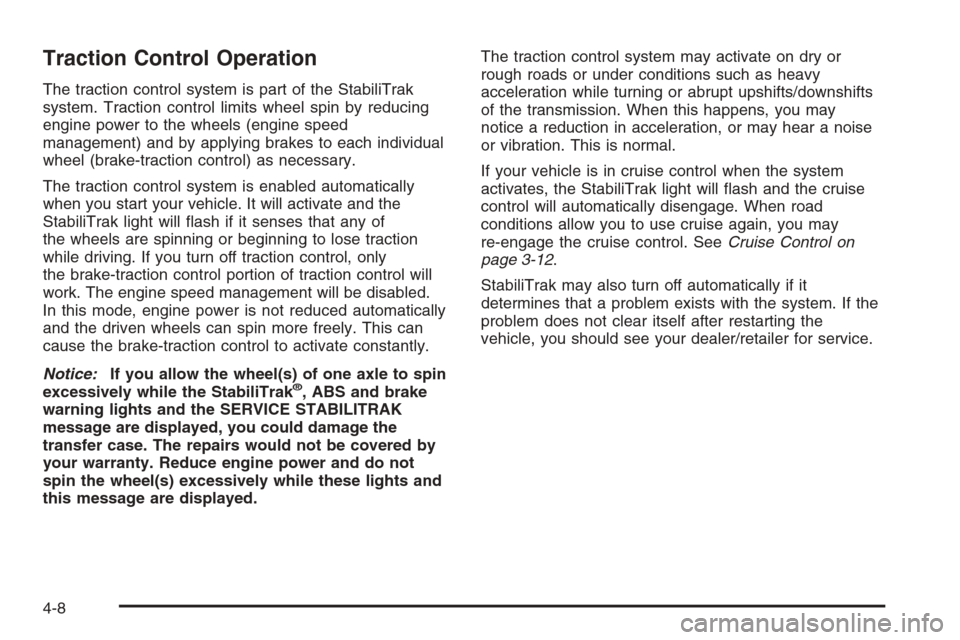
Traction Control Operation
The traction control system is part of the StabiliTrak
system. Traction control limits wheel spin by reducing
engine power to the wheels (engine speed
management) and by applying brakes to each individual
wheel (brake-traction control) as necessary.
The traction control system is enabled automatically
when you start your vehicle. It will activate and the
StabiliTrak light will �ash if it senses that any of
the wheels are spinning or beginning to lose traction
while driving. If you turn off traction control, only
the brake-traction control portion of traction control will
work. The engine speed management will be disabled.
In this mode, engine power is not reduced automatically
and the driven wheels can spin more freely. This can
cause the brake-traction control to activate constantly.
Notice:If you allow the wheel(s) of one axle to spin
excessively while the StabiliTrak
®, ABS and brake
warning lights and the SERVICE STABILITRAK
message are displayed, you could damage the
transfer case. The repairs would not be covered by
your warranty. Reduce engine power and do not
spin the wheel(s) excessively while these lights and
this message are displayed.The traction control system may activate on dry or
rough roads or under conditions such as heavy
acceleration while turning or abrupt upshifts/downshifts
of the transmission. When this happens, you may
notice a reduction in acceleration, or may hear a noise
or vibration. This is normal.
If your vehicle is in cruise control when the system
activates, the StabiliTrak light will �ash and the cruise
control will automatically disengage. When road
conditions allow you to use cruise again, you may
re-engage the cruise control. SeeCruise Control on
page 3-12.
StabiliTrak may also turn off automatically if it
determines that a problem exists with the system. If the
problem does not clear itself after restarting the
vehicle, you should see your dealer/retailer for service.
4-8
Page 309 of 538
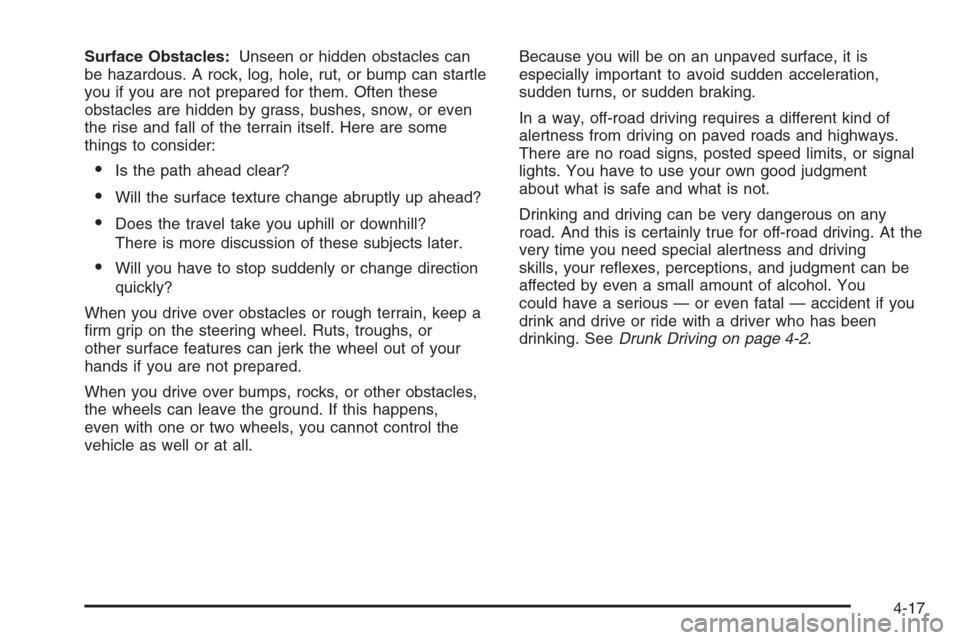
Surface Obstacles:Unseen or hidden obstacles can
be hazardous. A rock, log, hole, rut, or bump can startle
you if you are not prepared for them. Often these
obstacles are hidden by grass, bushes, snow, or even
the rise and fall of the terrain itself. Here are some
things to consider:
Is the path ahead clear?
Will the surface texture change abruptly up ahead?
Does the travel take you uphill or downhill?
There is more discussion of these subjects later.
Will you have to stop suddenly or change direction
quickly?
When you drive over obstacles or rough terrain, keep a
�rm grip on the steering wheel. Ruts, troughs, or
other surface features can jerk the wheel out of your
hands if you are not prepared.
When you drive over bumps, rocks, or other obstacles,
the wheels can leave the ground. If this happens,
even with one or two wheels, you cannot control the
vehicle as well or at all.Because you will be on an unpaved surface, it is
especially important to avoid sudden acceleration,
sudden turns, or sudden braking.
In a way, off-road driving requires a different kind of
alertness from driving on paved roads and highways.
There are no road signs, posted speed limits, or signal
lights. You have to use your own good judgment
about what is safe and what is not.
Drinking and driving can be very dangerous on any
road. And this is certainly true for off-road driving. At the
very time you need special alertness and driving
skills, your re�exes, perceptions, and judgment can be
affected by even a small amount of alcohol. You
could have a serious — or even fatal — accident if you
drink and drive or ride with a driver who has been
drinking. SeeDrunk Driving on page 4-2.
4-17
Page 389 of 538
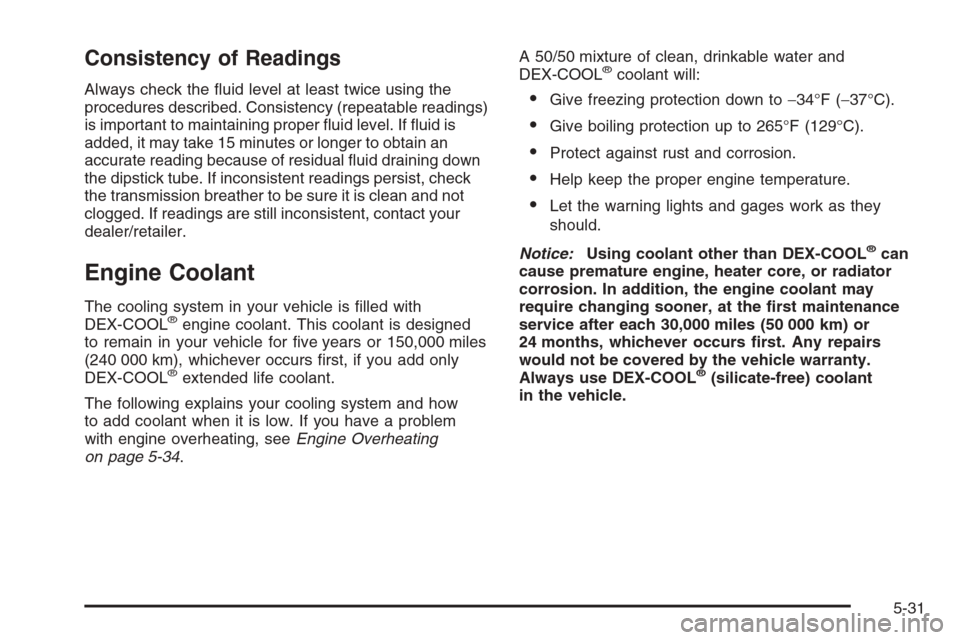
Consistency of Readings
Always check the �uid level at least twice using the
procedures described. Consistency (repeatable readings)
is important to maintaining proper �uid level. If �uid is
added, it may take 15 minutes or longer to obtain an
accurate reading because of residual �uid draining down
the dipstick tube. If inconsistent readings persist, check
the transmission breather to be sure it is clean and not
clogged. If readings are still inconsistent, contact your
dealer/retailer.
Engine Coolant
The cooling system in your vehicle is �lled with
DEX-COOL®engine coolant. This coolant is designed
to remain in your vehicle for �ve years or 150,000 miles
(240 000 km), whichever occurs �rst, if you add only
DEX-COOL
®extended life coolant.
The following explains your cooling system and how
to add coolant when it is low. If you have a problem
with engine overheating, seeEngine Overheating
on page 5-34.A 50/50 mixture of clean, drinkable water and
DEX-COOL
®coolant will:
Give freezing protection down to−34°F (−37°C).
Give boiling protection up to 265°F (129°C).
Protect against rust and corrosion.
Help keep the proper engine temperature.
Let the warning lights and gages work as they
should.
Notice:Using coolant other than DEX-COOL
®can
cause premature engine, heater core, or radiator
corrosion. In addition, the engine coolant may
require changing sooner, at the �rst maintenance
service after each 30,000 miles (50 000 km) or
24 months, whichever occurs �rst. Any repairs
would not be covered by the vehicle warranty.
Always use DEX-COOL
®(silicate-free) coolant
in the vehicle.
5-31
Page 531 of 538
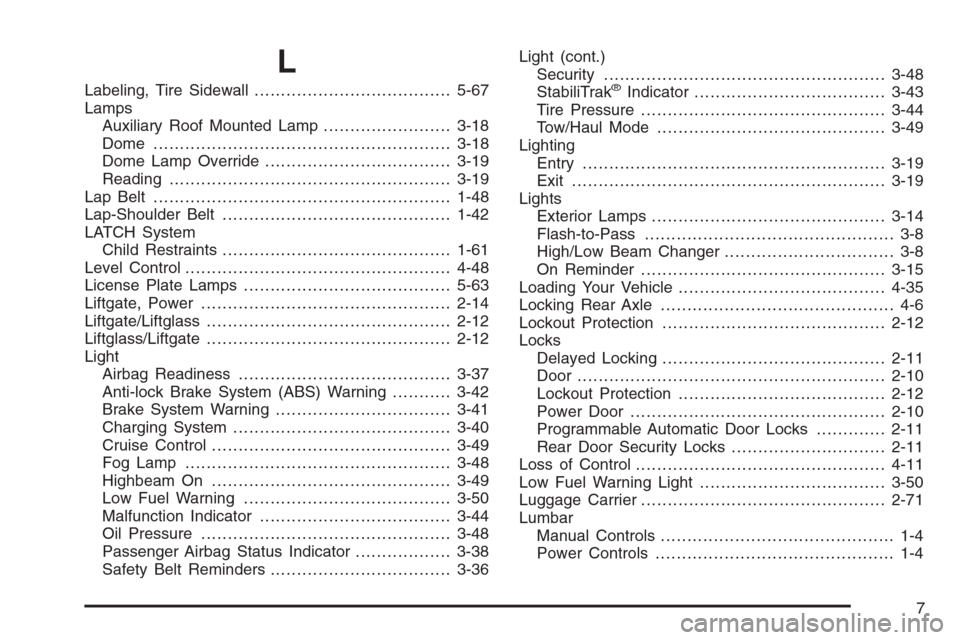
L
Labeling, Tire Sidewall.....................................5-67
Lamps
Auxiliary Roof Mounted Lamp........................3-18
Dome ........................................................3-18
Dome Lamp Override...................................3-19
Reading.....................................................3-19
Lap Belt........................................................1-48
Lap-Shoulder Belt...........................................1-42
LATCH System
Child Restraints...........................................1-61
Level Control..................................................4-48
License Plate Lamps.......................................5-63
Liftgate, Power...............................................2-14
Liftgate/Liftglass..............................................2-12
Liftglass/Liftgate..............................................2-12
Light
Airbag Readiness........................................3-37
Anti-lock Brake System (ABS) Warning...........3-42
Brake System Warning.................................3-41
Charging System.........................................3-40
Cruise Control.............................................3-49
Fog Lamp ..................................................3-48
Highbeam On.............................................3-49
Low Fuel Warning.......................................3-50
Malfunction Indicator....................................3-44
Oil Pressure...............................................3-48
Passenger Airbag Status Indicator..................3-38
Safety Belt Reminders..................................3-36Light (cont.)
Security.....................................................3-48
StabiliTrak®Indicator....................................3-43
Tire Pressure..............................................3-44
Tow/Haul Mode...........................................3-49
Lighting
Entry.........................................................3-19
Exit...........................................................3-19
Lights
Exterior Lamps............................................3-14
Flash-to-Pass............................................... 3-8
High/Low Beam Changer................................ 3-8
On Reminder..............................................3-15
Loading Your Vehicle.......................................4-35
Locking Rear Axle............................................ 4-6
Lockout Protection..........................................2-12
Locks
Delayed Locking..........................................2-11
Door ..........................................................2-10
Lockout Protection.......................................2-12
Power Door ................................................2-10
Programmable Automatic Door Locks.............2-11
Rear Door Security Locks.............................2-11
Loss of Control...............................................4-11
Low Fuel Warning Light...................................3-50
Luggage Carrier..............................................2-71
Lumbar
Manual Controls............................................ 1-4
Power Controls............................................. 1-4
7
Page 537 of 538
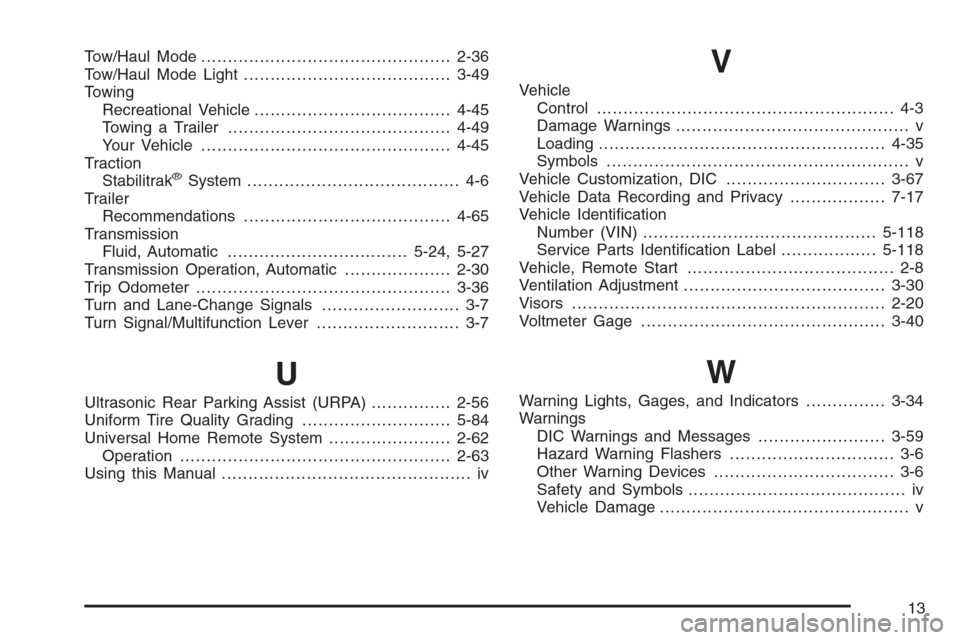
Tow/Haul Mode ...............................................2-36
Tow/Haul Mode Light.......................................3-49
Towing
Recreational Vehicle.....................................4-45
Towing a Trailer..........................................4-49
Your Vehicle...............................................4-45
Traction
Stabilitrak
®System........................................ 4-6
Trailer
Recommendations.......................................4-65
Transmission
Fluid, Automatic..................................5-24, 5-27
Transmission Operation, Automatic....................2-30
Trip Odometer................................................3-36
Turn and Lane-Change Signals.......................... 3-7
Turn Signal/Multifunction Lever........................... 3-7
U
Ultrasonic Rear Parking Assist (URPA)...............2-56
Uniform Tire Quality Grading............................5-84
Universal Home Remote System.......................2-62
Operation...................................................2-63
Using this Manual............................................... iv
V
Vehicle
Control........................................................ 4-3
Damage Warnings............................................ v
Loading......................................................4-35
Symbols......................................................... v
Vehicle Customization, DIC..............................3-67
Vehicle Data Recording and Privacy..................7-17
Vehicle Identi�cation
Number (VIN)............................................5-118
Service Parts Identi�cation Label..................5-118
Vehicle, Remote Start....................................... 2-8
Ventilation Adjustment......................................3-30
Visors...........................................................2-20
Voltmeter Gage..............................................3-40
W
Warning Lights, Gages, and Indicators...............3-34
Warnings
DIC Warnings and Messages........................3-59
Hazard Warning Flashers............................... 3-6
Other Warning Devices.................................. 3-6
Safety and Symbols......................................... iv
Vehicle Damage............................................... v
13